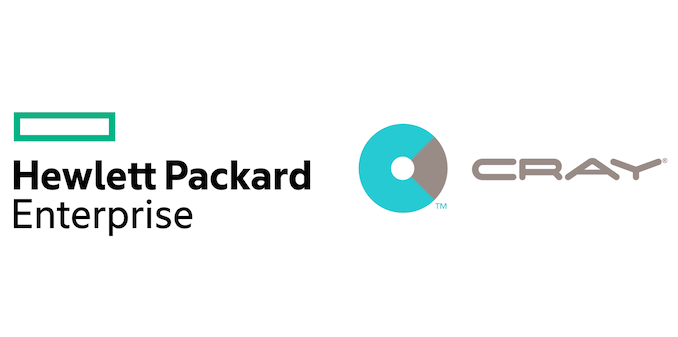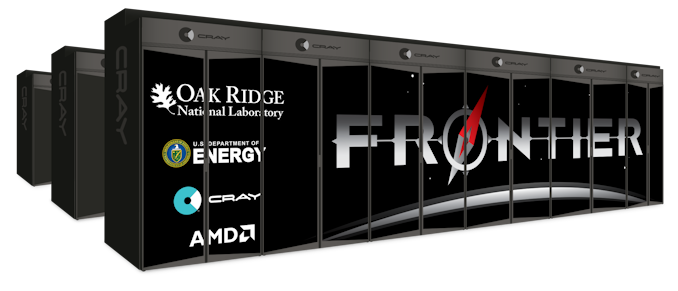Hewlett Packard Enterprise to Acquire Cray for $1.3 Billion
by Ryan Smith on May 17, 2019 9:45 AM EST- Posted in
- HPC
- Cray
- HPE
- Supercomputers

This morning Hewlett Packard Enterprise and Cray are announcing that HPE will be buying out the supercomputer maker for roughly 1.3 billion dollars. Intending to use Cray’s knowledge and technology to bolster their own supercomputing and high-performance computing technologies, when the deal closes, HPE will become the world leader for supercomputing technology.
Cray of course needs no introduction. The current leader in the supercomputing field and founder of supercomputing as we know it, Cray has been a part of the supercomputing landscape since the 1970s. Starting at the time with fully custom systems, in more recent years Cray has morphed into an integrator and scale-out specialist, combining processors from the likes of Intel, AMD, and NVIDIA into supercomputers, and applying their own software, I/O, and interconnect technologies.
The timing of the acquisition announcement closely follows other major news from Cray: the company just landed a $600 million US Department of Energy contract to supply the Frontier supercomputer to Oak Ridge National Laboratory in 2021. Frontier is one of two exascale supercomputers Cray is involved in – the other being a subcontractor for the 2021 Aurora system – and in fact Cray is involved in the only two exascale systems ordered by the US Government thus far. So in both a historical and modern context, Cray was and is one of the biggest players in the supercomputing market.
HPE for its part has some supercomputing exposure as well, however it’s nothing on the scale of what Cray has done. So for HPE, the deal represents an opportunity for the firm to acquire the know-how and technology needed to augment and evolve their own supercomputer and HPC technologies. Among other things, this deal means HPE will be picking up Cray’s Shasta system architecture as well as their new Slingshot interconnect, both of which will be core parts of Frontier.
The company sounds especially interested in incorporating these technologies into their current HPC plans. While supercomputers attract a lot of attention for obvious reasons, somewhat smaller systems are sold in much higher numbers due to costs and computing needs. Like many other hardware vendors, HPE is riding the wave of big data, including AI-driven analytics, and the company intends to grow their capabilities here using Cray’s technology. Interestingly, Cray is actually the second supercomputer manufacturer picked up by HPE over its lifetime; the company also picked up the remaining assets of Silicon Graphics back in 2016.
Broadly speaking, major acquisitions and mergers in the supercomputing space are rare events. Due to their ever-increasing price tag, only a small number of world-class supercomputers are sold each year. And due to these prices the buyers are often governments, which inevitably gives supercomputer construction a nationalistic element to it. None the less, because costs are increasing – Frontier is the US’s most expensive system yet at over $500M for the system alone – there is some pressure for consolidation as fewer systems get sold and overall performance efficiency increases have been slowing down as well. It’s not too surprising then that HPE’s plans include using Cray’s technologies to improve HPE GreenLake, the company’s HPC-as-a-Service offering.
Under the terms of the deal, HPE will be paying Cray shareholders $35 in cash for each Cray share, which is a notable price premium over Cray’s average stock price over the last year. This puts the total value of the deal at nearly $1.3 billion, with HPE expecting the deal to close in the first quarter of FY2020.
Source: HPE











46 Comments
View All Comments
SarahKerrigan - Friday, May 17, 2019 - link
Are you implying that the US government scheduled a contract award purely to be a marketing boost to AMD?Korguz - Friday, May 17, 2019 - link
SarahKerrigan according to HStewart.. its ok for intel to announce something like this.. but if amd does it.. its nothing but a PR announcement...HStewart : FYI intel has done the " me too " thing as well... intel COPIED amd's x86 64 bit extensions, cause they HAD to as the industry didnt want to have to deal with 2 versions of x86 64 bit, and, they COPIED amd with the on die memory controller... so enough with the " me too " crap you are accusing AMD of doing....
Lord of the Bored - Saturday, May 18, 2019 - link
See, that's okay. Intel is COPYING something that AMD STOLE from them in the first place. Second-source manufacturing agreements from almost half a century ago are clearly evidence of criminal enterprise, as opposed to "common business practice half a century ago".FunBunny2 - Sunday, May 19, 2019 - link
"Intel is COPYING something that AMD STOLE "the problem is simple: over time, for every problem, a most effective solution emerges. in the case of microprocessor cpu, there's the added issue of market share driven monopoly. no one, sane anyway, ever thought X86 was the best ISA at the beginning or ever. but 1-2-3 and DOS forced us into the M$/Intel world. once that base was established, extensions had to be optimized against it. so, in time, functionality coalesced. and, last time I checked, nothing in maths can be patented.
smilingcrow - Saturday, May 18, 2019 - link
Wasn't the DEC Alpha the first CPU with an on die memory controller?Of course they will copy each other at times and AMD have had some great firsts, at least with x86.
But when you consider AMD are riding on the coat tails of Intel's architecture the whole copying thing becomes somewhat moot.
It's just good to have AMD back on form after a bleak period; the competition is good.
ilt24 - Saturday, May 18, 2019 - link
@smilingcrow..."Wasn't the DEC Alpha the first CPU with an on die memory controller?"I'm not sure if DEC was first, HP, Sun and ARM also had on die memory controllers on their processors in the 90's...also Intel created the 386SL (a more power efficient 386 for laptops) in the early 90's and it had the memory controller on die.
arashi - Saturday, May 18, 2019 - link
Don't expect too much comprehension from Intel marketing when his job depends on his misinformation guised under misunderstanding.GoHack314 - Friday, May 17, 2019 - link
Lets see, Compaq purchased DEC Computer (Digital Equipment Corporation), who manufactured what were called, Mini-Computers (VAX), and who were "WAY" ahead on processor technology, including both 64 and even 128 bit processors and software, way back in the '90's, and broke them up and sold off much of their advanced technology, destroying them, then HP buys Compaq, most likely for what they had in regards to DEC technology, and outside of using their name for a while, destroyed them. Then HP went and bought up Voodoo Gaming Computers, a competitor to Alienware at the time, and destroyed them, and now they are buying up Cray, and as we have seen in the past, suck up their technology and knowledge, and selling off what they don't need, eventually destroying them as well. :(Oxford Guy - Friday, May 17, 2019 - link
Yes, HP's track record doesn't invite a lot of optimism.Kevin G - Friday, May 17, 2019 - link
HPE also bought SGI whose technology its the core of the SuperDome Flex line of ultra high end servers. The second biggest negative* I can cite its that under HPE, the NUMALink architecture isn't being leveraged to its fullest as it is supposed to scale to 256 sockets. This isn't that dire due to the number of sales beyond 32 socket. In addition, such system bump up against various x86 architectural limits like physically addressable memory (64 TB currently), and total core count (4096).*For those wondering what the biggest negative is: pricing.